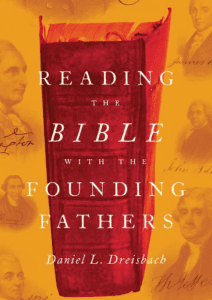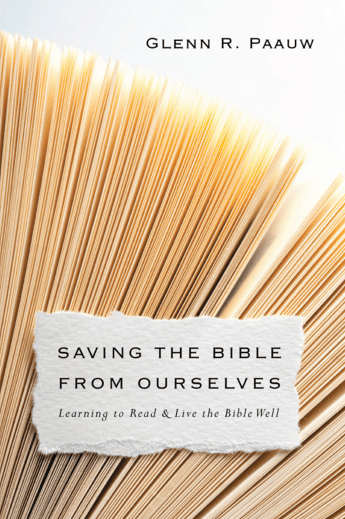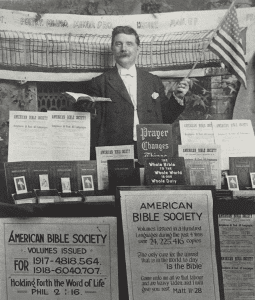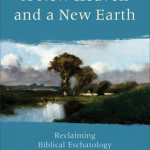The Bible has always played an unimpeachable role in Christianity … It is not, however, the central focus of Christian faith. That position belongs to God, and Christians are called to trust him. … Coming to the realization that the Gospel is not at stake with every interpretive challenge will encourage a fruitful dialog between religious and critical readings of Scripture. – Peter Enns, (p. 159-160)
 The final essay in the new book by Marc Zvi Brettler (Brandeis University), Peter Enns (Eastern University) and Daniel J. Harrington (Boston College), The Bible and the Believer: How to Read the Bible Critically & Religiously is by Peter Enns. Following Brettler’s Jewish view and Harrington’s Catholic view, Enns looks at a Protestant view of scripture and biblical criticism. Because Protestantism covers a broad range from the very liberal (for whom biblical criticism is no problem) to the very conservative (for whom it is heretical), he chooses to focus on the broad middle, that portion of Protestants who take scripture seriously but who also have interest in the ways in which biblical criticism and Christian faith can (or must) be in dialogue.
The final essay in the new book by Marc Zvi Brettler (Brandeis University), Peter Enns (Eastern University) and Daniel J. Harrington (Boston College), The Bible and the Believer: How to Read the Bible Critically & Religiously is by Peter Enns. Following Brettler’s Jewish view and Harrington’s Catholic view, Enns looks at a Protestant view of scripture and biblical criticism. Because Protestantism covers a broad range from the very liberal (for whom biblical criticism is no problem) to the very conservative (for whom it is heretical), he chooses to focus on the broad middle, that portion of Protestants who take scripture seriously but who also have interest in the ways in which biblical criticism and Christian faith can (or must) be in dialogue.
Enns begins by discussing a bit of the history describing how we got to the present situation. He looks at the concept of sola scriptura developed in the reformation. He describes the challenges of the 19th century, those introduced by science (the age of the earth and Darwin’s publication of On The Origin of Species), archaeological discoveries (especially ancient Egyptian, Mesopotamian, and Canaanite texts), and biblical criticism (especially textual and source criticism). This history provides some context for the discussion of the relationship between critical and religious readings of scripture that follows.
Areas of Conflict. Enns sees two major areas where Protestants need some re-thinking as they seek an effective way to synthesize a religious reading of scripture with biblical criticism. The first is the creative way in which the New Testament authors interpret the Old Testament text. They simply did not approach or use the text the way that modern Protestants approach and use the text. We’ve discussed this in a number of posts including Paul’s (First Century) Use of Scripture and Out of Egypt? … Say What? among others and so will pass on to the second area of conflict.
The OT and the Problem of History. The second major area of conflict Enns outlines involves the historical accuracy (or not) of the OT text. A major point, one accepted by most scholars, is that “the Old Testament authors do not recount events as modern historians do but as storytellers, … [thus] intersection between the biblical text and historical events must be discerned on a case-by-case basis.” (p. 149)
The assumption that the text must be free from historical “error” to be the inspired Word of God is a modern assumption imposed from outside, a presumption of what the bible ought to be, not an assessment of what the Bible is.
Presumably, what is operating under the surface is an assumption that good history writing (the kind God would certainly engage in) would be up to our modern expectations of accuracy. But as we saw in the matter of the New Testament’s use of the Old, imposing modern assumptions onto ancient texts creates more problems than it solves. Protestants must be willing to learn to be comfortable with how the Bible actually behaves rather than presuming how it should behave and then massaging the data to align with that theory. (p. 150)
Enns is an Old Testament scholar, his dissertation (Harvard ’94) is on the book of Exodus. He has written commentaries on Exodus and on Ecclesiastes. Here he uses the biblical account of the exodus to illustrate the historical concerns that crop up in a “typical” Protestant reading of the Old Testament. That there is a historical memory behind the account of the exodus is entirely plausible, even likely. That the account we have in the book of Exodus lives up to modern views of the historical accuracy to be expected in “good” histories is much less plausible. That ca. 2 million Hebrews (600K men plus women and children) left Egypt at a time when the total population of Egypt was ca. 3 million strains credulity. But these details aside, the biblical account of the exodus is a powerful text with deep religious significance. Among other things Enns describes how the account of the plagues and the parting of the Red Sea is an account of a cosmic battle where Yahweh defeats, with ease, the gods of Egypt. Exodus 12:12 makes this explicit.
For I will pass through the land of Egypt on that night, and I will strike down all the firstborn in the land of Egypt, both man and beast; and against all the gods of Egypt I will execute judgments—I am YHWH.
Most Christians simply pass right over the last half of this verse… against all the gods of Egypt I will execute judgments—I am YHWH … it has no impact. But it is a very important key to the meaning of the story of the exodus from Egypt. As Enns puts it:
Exodus is a battle scene between Israel’s God and the gods of Egypt. Israel’s God – the God of a first homeless and then enslaved people – marches into the territory of the superpower of the day, toys with its kings and gods, and then delivers a crippling strike in the tenth plague. The final blow, as we saw, occurs at the Red Sea. Yahweh splits the Red Sea, as he had split the sea/chaos in primordial times, thus defeating Egypt’s entire army and bringing freedom to Israel (Exod 14:15-18)
Again, whatever historical core there may be to the exodus story, the story itself is clearly addressed in literary conventions of the time, which includes nods to stories from other ancient cultures. It is a noble enterprise, which I genuinely support, to continue to explore the basic historical reliability and plausibility of the book of Exodus. But, at the end of the day, we are left with a story that does something other than simply report events. Exodus is a theological statement that uses idioms of the day to paint a portrait of Israel’s glorious beginnings and of the God they serve. (p. 155-156)
Whether you find the interpretation Enns gives convincing or not, it is a great starting point for conversation. Protestants need not and should not accept lock, stock, and barrel, the current conclusions of critical scholarship. As Enns notes a bit later – “Not every critical reading of Scripture is convincing or of equal value. Biblical scholarship has its share of trends and sloppy thinking.” (p. 160) But there is much of value to be learned from critical scholarship – and we may miss some deep religious significance and insight if we dismiss it out-of-hand and focus on modern expectations for histories. Discerning engagement and dialogue are key.
So how does Enns wrap this all up? With a personal reflection on his journey through college, seminary, graduate school and beyond. There are, he suggests, three options for the believer when it comes to religious and critical readings of the Bible: avoidance, defensiveness, and synthesis. Synthesis is, Enns suggests, the best way forward. And this has led him to some valuable lessons:
1. The Bible is not the center of the Christian faith. The Bible plays a central and essential role in Christian faith, but it is not the focus or the foundation of our faith. God is the focus and the foundation. “Scripture bears witness to God and what he has done in Christ, but Scripture’s witness-bearing role should not be confused with the one to whom Scripture bears witness … Coming to the realization that the Gospel is not at stake with every interpretive challenge will encourage a fruitful dialog between religious and critical readings of Scripture.” (p. 159-160)
2. Fear can quickly derail the dialogue between faith and critical readings of Scripture. Critical readings are not always right but critical scholarship has also brought us considerable new and important insight into the text. Fear can prevent the believer from engaging the scholarship with discernment – a development that impoverishes us all.
When dialogue is stifled and aggressive responses quickly follow – whether by popular opinion or prevailing power structures – lurking not too far beneath the surface is an unstated fear: familiar, protective, theological boundaries are being threatened. (p. 160)
This fear prevents the careful study, open debate, and back and forth interaction necessary to develop a clear and robust faith in the modern world. Such a faith is possible. The modern myth that reason has eliminated the possibility of a rational faith is a false myth. But such a faith hard to find when fear rules the roost. Enns gives his experience but I will add a note of my own here. Synthesis is the only way forward. Avoidance arising from fear is counter productive. It leads to a fragile and bracketed faith. When one both knows what one is “supposed to” believe and that one does not believe much of it there is a constant unhealthy tension, something like walking a tightrope. It is next to impossible to be either comfortable or an effective witness when this is the case. Defensiveness, also arising from fear, is even worse. The arguments, quite frankly, border on the ridiculous. Protestantism must learn to carry on a profitable dialogue with critical scholarship taking a posture of engaged discernment and careful study.
3. An unsettled faith is a maturing faith. Spiritual struggles are an important part of anyone’s faith. This is something well recognized throughout the history of the Christian church and remains true today.
In fact, spiritual alienation can be a period of necessary spiritual purging of one’s views of God and the Bible that have become caricatures, mere reflections of one’s ego that need to be left behind. Such periods may feel like a loss of faith when, in fact, they are merely exposing an immature faith. (p. 161)
The last may be the hardest lesson of all. We have come to expect clear answers and a happy ever after acceptance. But life seldom provides such finality or clarity. A healthy faith grows and matures, at different rates and in different directions for different people, it doesn’t stagnate within a one-size-fits-all simplicity.
The goal of The Bible and the Believer is to demonstrate how critical and religious religious readings of Scripture can coexist. The essays and responses show how three scholars from three different traditions have found a fruitful synthesis. A book well worth reading.
Should a reverent approach include the realization that Scripture is an ancient text produces in an ancient context? How might this change the understanding of Scripture?
How should religious and critical readings of scripture be in dialogue?
If you wish to contact me directly you may do so at rjs4mail[at]att.net.
If interested you can subscribe to a full text feed of my posts at Musings on Science and Theology.











